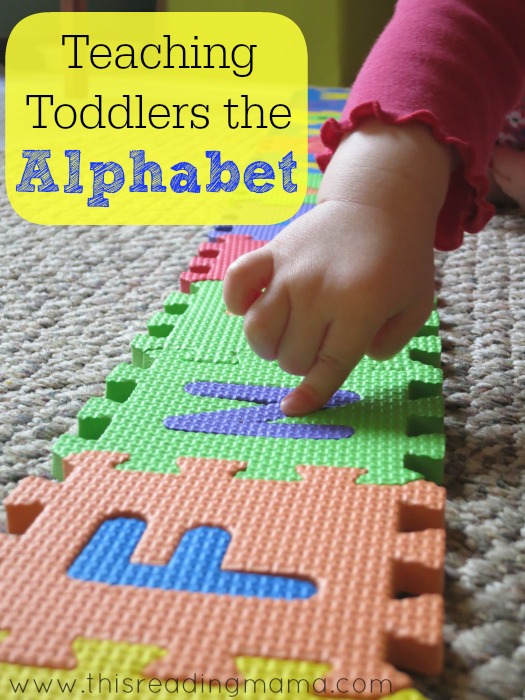
One of my literacy goals in the younger years (with toddlers and preschoolers) is to help them build a solid foundation of letters and letter sounds so they can build on that for later reading and spelling.
You may think I’m crazy. Teaching toddlers the alphabet? Aren’t they too young?
But teaching toddlers the alphabet does not necessarily need to look like “teaching”. There’s no desk. No workbook or letter of the week formula. What you will find is lots of intentional play and literacy integration/immersion throughout the day through multiple and meaningful exposure.
*This post contains affiliate links.
Teaching Toddlers the Alphabet Through Intentional Play
I like to hoard collect toys and manipulatives that can be used for play, but can also serve as a way to introduce letters to my tots and preschoolers.
Alphabet puzzles are the perfect example. We’ve used puzzles in different different ways, such as an assessment tool for letters or visualizing letters for my pre-writer. And we have several different alphabet puzzles (a few came from the $1 store), but right now my tot’s favorite puzzle is our chunky Melissa & Doug ABC Puzzle. I leave it out on a smaller table and she loves to go play with it pretty much every day.

This particular day, she went over and starting stacking the pieces. I watched for a little bit and then began to comment on her play as she stacked, integrating letter names- “Oh, you just put the M on top!” I did this for a few letters and then left her to finish her play. Note that I didn’t take over her play and ask her to start naming the letters. It just flowed naturally into HER play.
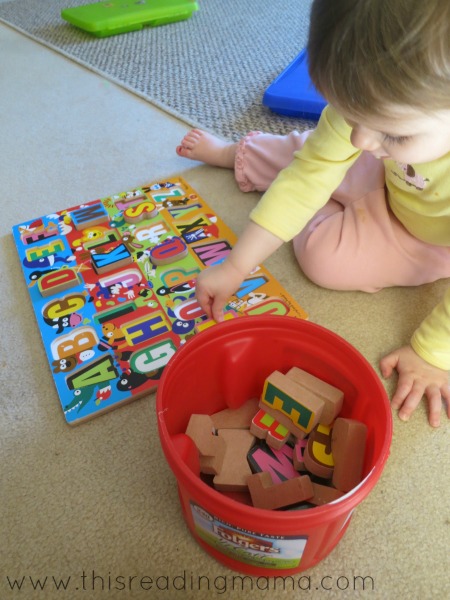
Other days, she’ll bring me the puzzle and ask that we name the letters together. Now, you may be thinking, “My toddler would NEVER do that!”, but the key is that I let her lead. If she only wants to name 7 letters, that’s all we do in that sitting. I don’t take over and demand that we do all 26. I follow her.
Another favorite toy we use is our foam alphabet letters {and if you have a foam puzzle, use the pieces from that}. The bathtub has always been one of my favorite places to play with letters because my audience is “captive” and most kids LOVE bath time.
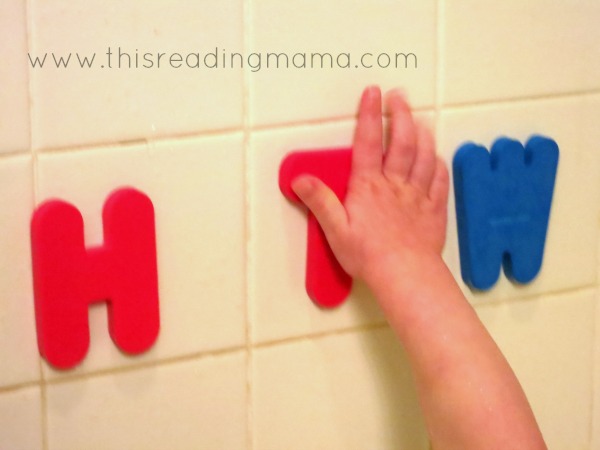
A simple way we play with letters is she puts the foam letters on the wall, while I name them. Then she swipes them off with her hand or splashes them with water and they come falling back down. Giggles and “do ‘gain” usually follow this, so we do it multiple times. I don’t have an agenda. I just name the letters she puts up and she knocks them down. Multiple and meaningful exposure.
Teaching Toddlers the Alphabet Every Day
One place I always like to start with toddlers and preschoolers is their name. Nothing seems more important to them. All my kids have their names on their wall in their bedrooms.
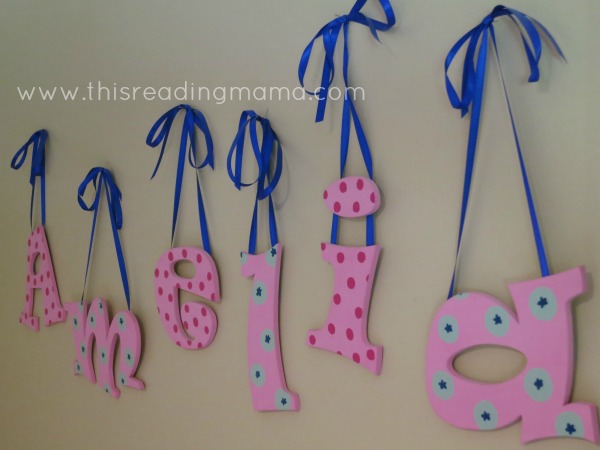
When they were toddlers, as we played in their room or as I put them to bed, I pointed to each letter and said, “N-A-T-H-A-N…Nathan!” while tickling their belly. They got to the point that they asked me to do it. I was quite shocked when NSis {currently 2 years old} woke up early from her nap the other day and was overheard on her monitor, spelling her own name over and over again.
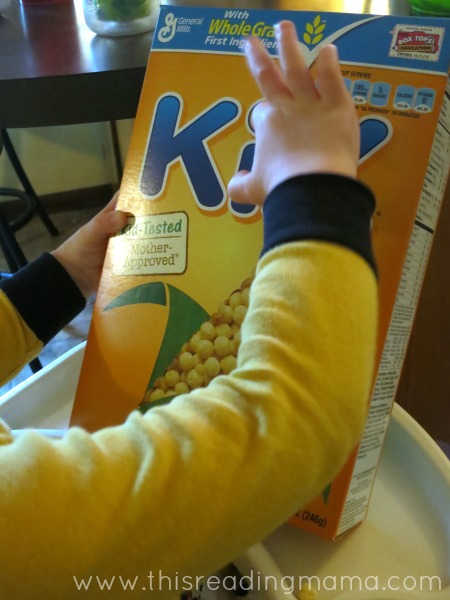
Letters are EVERYWHERE; take advantage of it! On the grocery store sign, on the stop sign, on the cereal box! Just the other morning, NSis exclaimed “I, I, I!” After some time of searching for an eye, I realized she meant the letter i on the cereal box!
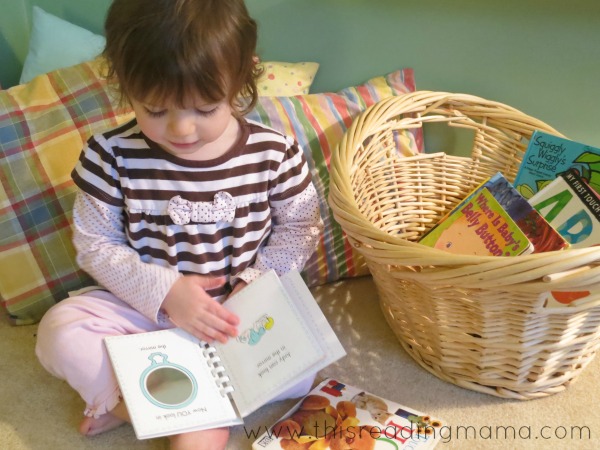
Reading TO toddlers, pointing out letters on the page, maybe just the letters in their own name at first, is a great way to naturally integrate letter learning into their day. Alphabet books are a favorite in our house, too. I also keep a book basket(s) on her level, just for her to explore books on her own. Sometimes, it’s a totally independent thing while other times, I join in her reading and add that extra layer of letter learning.
You’ll LOVE our Hands-on Alphabet Activities for Little Learners!
Enjoy teaching!
~Becky
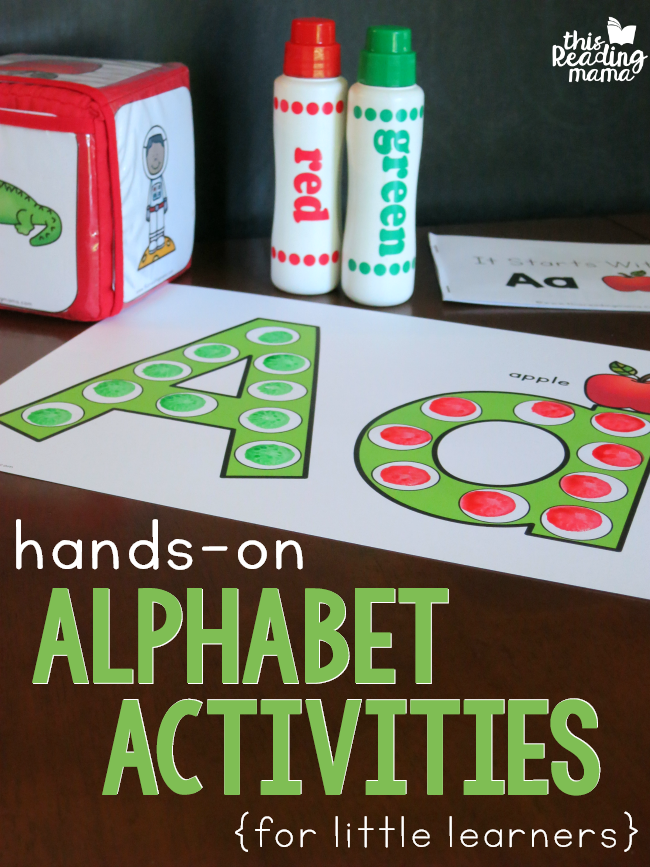
I agree completely that letter learning should be done in a playful manner. My oldest son learned all of his letters this way by age 2 1/2. My youngest son who just turned 2 is now doing the same. A little ABC play each day does wonders! Thanks so much for the ideas.
Thank you, Jodie!
You have nice ideas for incorporating learning naturally with playtime, but I have to disagree with the emphasis on learning letter names. Learning the sounds that each letter makes is much more helpful for pre-readers since letters are written symbols of sounds.
I agree with you that letter sounds are helpful for readers, too. We work on those a bit more as my kids are around age 3; so by 4, they know both their letters and letter sounds. Many letter names have the actual sound within them, so I have found so far that my kiddos don’t have too much trouble with the sounds, even after being introduced to the name. Your approach sounds Montessori to me (which I also love). 😉
I think, as with many things, it depends on the child. Our oldest recognized all her letters by name when she was 20 months old (I was reading Veggietales Bob And Larry’s ABC’s to her daily when she began yelling the letters out before me when I’d turn the page!) Soon after, she recognized her name, Mama, Papa, and Oma and Opa (German for gramma and grandpa) when I’d write them on a dry erase board. It was a very quick transition from naming the letters, to teaching the sounds they made, to combining those sounds in short vowel sound words. She was an eager learner, reading well at age 3 and at a third grade level reading with fluctuation in her voice by age 4. She just turned 17, is an incredible speller and still loves to read.
Our two sons that followed both learned their letter names first as well, and while they did not catch on as quickly, they both began reading by age 4 and are reading at age appropriate levels. Son number 3 (child number 4) is having the most trouble putting his sounds together into words. He is now 5 and I am just having to constantly remind myself, they’re all different, and will learn at their own pace. Child number 5 (another girl…yay) started speaking much later than everyone else, but now that she is, she is spitting out full sentences that I wasn’t even aware she knew the meaning of. She’s now 26 months and loves to be read to. She has surprised me by picking magnetic letters off the fridge and occasionally naming them correctly. I started the Montessori approach with her recently and she seemed to take to it quickly, repeating the sounds of some of the letters in her name. But because I always emphasized letter names before, she still uses names rather than sounds when she’s “writing”.
Either way, they’re going to have to learn both. Their brains are amazing little sponges, I don’t think it makes a whole lot of difference which they learn first, the names or the sounds. Ultimately, they will read and it will become second nature very quickly.
what symbols should we introduce first small or capital?
I would not limit yourself to just one if you’re teaching recognition unless it seems to confuse your child. If your child struggles, I’d probably stick with uppercase since they are generally easier to distinguish than lowercase.
Thanks for this 🙂 my 2.5 yr old recognizes all her letters and number 0-10. She knows so much. I love teaching her new things. She loves it too! I also taught her which letters were vowels a couple days ago. And how to count backwards. I really want to teach her the sounds letters make. I didn’t even think about it.
I totally agree! Our two year old has learned most of the letters and sounds from playing and the Leapfrog Letters DVD. He lover it and points out letters everywhere we go!